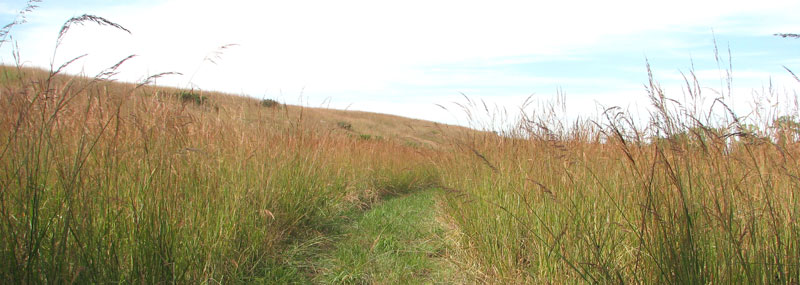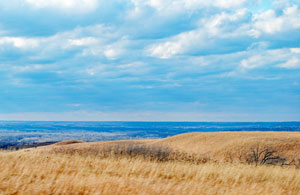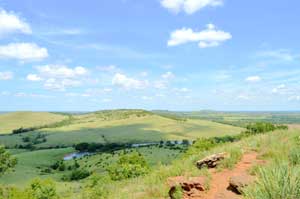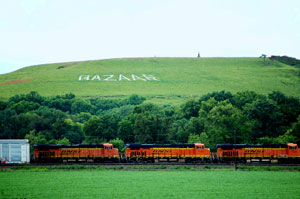The Flint Hills, historically known as Bluestem Pastures or Blue Stem Hills, is a region in eastern Kansas and north-central Oklahoma. It was named for the abundant flint eroded from the bedrock near or at the surface.
This band of hills extends from Marshall and Washington Counties in the north to Cowley County, Kansas, and Kay and Osage Counties in Oklahoma, to Geary and Shawnee Counties west to east. In Oklahoma, the formation is often referred to as the Osage Hills. In east-central Kansas, the Flint Hills encompass about 20-25% of the state.
The Flint Hills are a distinct region because it has the most densely covered intact tallgrass prairie in North America. Due to its rocky soil, the early settlers were unable to plow the area, resulting in the prevalence of cattle ranches instead of the cropland more typical of the Great Plains. Few trees mark this temperate grassland, but abundant forbs and grasses can grow up to ten feet tall.
Human activity in the Kansas Flint Hills can be traced back about 12,000 years, when people used the area’s natural resources to hunt large mammals and gather wild plants. Trade networks extended well beyond the Plains. About 2,200 years ago, the use of domesticated plants, producing ceramics, and hunting with a bow and arrow began. By about 1,000 A.D., domesticated plants and associated artifacts reflect a predominantly horticultural existence shifting to settled village life. By 1,500 A.D., more farming occurred, combined with increased bison hunting, due to the acquisition of the horse by Native Americans. In Kansas, these tribes included the Wichita, the Kanza, the Osage, and the Pawnee.
These native peoples grew crops and lived in semi-permanent homes along streams and creeks. The Flint Hills were a communal hunting ground for the tribes, who knew that the area was good grazing ground for bison. The Flint Hills also provided much-needed chert, also known as flint, which they used to make tools, weapons, arrowheads, and ceremonial pieces.
These Native people noticed that bison and other grazing animals were attracted to the tender, new plant life that grew immediately after lightning had set vast grass fires. As a result, they adapted this natural process to attract bison and other grazing animals to their Flint Hills hunting grounds by setting grass fires of their own and waiting for bison and other grazing animals to find new plant life.
By the time of contact with European explorers in the mid-1500s, the tribes had already established flourishing grassland cultures. They had become quite familiar with the tallgrass prairie and the ways necessary to succeed on it. Many of these adaptations would influence incoming American settlers.
Early tallgrass prairie explorers encountered what was to them a unique and intimidating landscape.
Spaniard Francisco Vasquez de Coronado was one of the first Europeans to visit central Kansas in the mid-1500s. However, after not finding large cities of gold and other riches, he and his group returned southwest. However, Spanish explorers and colonists brought cattle, horses, and the cattle culture to North America in the 1500s.
American explorer Zebulon Pike is credited with inadvertently coining the term “Flint Hills.” Passing through the area in September 1806, he made this journal observation:
“Passed very ruff flint hills. My feet blistered and very sore.”
When Euro-American settlers arrived in the 1850s, they struggled to farm the land due to the abundance of rocks in the soil. Observing the healthy bison on the land, they began to herd cattle, which, like the bison, fattened quite quickly on the rich prairie grasses. The settlers began building cattle ranches in the Flint Hills in the 1870s. With cattle driven up from Texas and the introduction of barbed wire, ranching boomed into a huge business, setting the foundations for present-day Flint Hills cattle culture.
At one point, 150 million acres of tallgrass prairie stretched from Texas to Canada. The majority transformed into the agricultural heartland of America through 200 years of settlement and development. American settlers carved up the tallgrass of Illinois, Iowa, Nebraska, Minnesota, North Dakota, and South Dakota. Their harvests fed a growing nation and world. But the Flint Hills would follow a different path. Never having been plowed over and remaining sparsely developed to this day, the Flint Hills represent the nation’s last expanse of intact tallgrass prairie.
Today, only four percent of the original tallgrass prairie ecosystem survives, with the most significant remaining piece in the Flint Hills.
Tallgrass prairie is regularly renewed by fire and grazing, which keeps back the growth of trees and shrubs.
Cattle ranching remains the backbone of the Flint Hills economy.
Four tallgrass prairie preserves are located in the Flint Hills. The largest of these, the Tallgrass Prairie Preserve in the Osage Hills near Pawhuska, Oklahoma, boasts a large population of bison and is an important refuge for other wildlife, such as the greater prairie-chicken. The other preserves, all located in Kansas, are the 17-square-mile Tallgrass Prairie National Preserve in northern Chase County, Kansas near Strong City, the Flint Hills Tallgrass Prairie Preserve east of Cassoday, and the Konza Prairie, which is managed as a tallgrass prairie biological research station by Kansas State University and is located near Manhattan, Kansas.
In Manhattan, Kansas, is the Flint Hills Discovery Center, a science and history museum focusing on the Flint Hills.
The Flint Hills Scenic Byway passes through the region in Kansas.
©Kathy Alexander/Legends of Kansas, updated July 2025.
Also See:
Sources:






